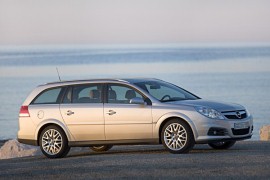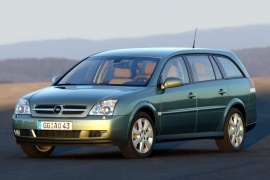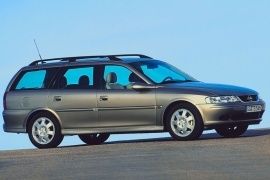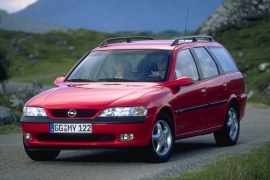OPEL Vectra Caravan Models/Series Timeline, Specifications & Photos
First production year: 1996
Engines: Gasoline, Diesel
Body style: Wagon (station wagon, estate, combi, touring)
Opel introduced the last generation of the mid-size model Vectra in 2002, followed by a facelift in 2005 for the entire range, just in time to meet the Euro 4 emission standards.
GM built the car on the same platform as the Saab 93, Chevrolet Malibu, or Cadillac BLS. Thus, the carmaker tried to lower its production costs, but the Vectra was still a pricy vehicle.
The facelift brought a completely new front fascia. It sported swept-back headlights and a thick, chromed, horizontal slat on the upper side of the grille. Its bumper was divided into three sections, with the side pods used for round fog lights. At the back, there were new taillights with clear lenses for the reversing lights.
Inside, the carmaker offered the Vectra a wide upholstery option, ranging between cloth and man-made leather. For the infotainment unit, all cars received a CD-Radio with buttons on the steering wheel. As an option, Opel offered an infotainment unit with a navigation system. The carmaker installed high-bolstered front seats for the OPC version, which was more of a fast wagon than a family car. In the back, it was the same flat bench for three adults, with a 60/40 split-folding system. This allowed an increase for the trunk space up to 1,850 liters (65.3 cu-ft).
Opel knew that the Vectra was not suitable for every budget but still offered it with a vast engine range, both gasoline and turbodiesel. In addition, depending on the powerplant, it provided a manual or an automatic transmission.
OPEL Vectra Caravan 1.6L 16V 5MT FWD (100 HP)
OPEL Vectra Caravan 1.8L 16V 5MT FWD (122 HP)
OPEL Vectra Caravan 1.8L 16V 5MT FWD (140 HP)
OPEL Vectra Caravan 2.0L 16V Turbo 6MT FWD (175 HP)
OPEL Vectra Caravan 2.2L 16V DGI 6MT FWD (155 HP)
The Vectra was already an established name on the market, and the third sequel of this mid-size contender built by Opel in Europe was launched at the 2002 Geneva Motor Show.
GM developed a new platform shared by Opel Vectra, Saab 9-3, and Saturn Aura. Since it had to compete with the best European sedans, such as the Volkswagen Passat and Ford's Mondeo, it had to be available as a station wagon, and it did it quite successfully, although this bodywork was unveiled only in late 2003, at the Frankfurt Motor Show.
The exterior featured a new design trend for its headlights, with a rectangular, swept-back look and a pair of headlamps inside. Its grille sported a horizontal slat and a round badge on it. The long-roof version featured a third, wide window behind the rear doors. Even though the design team tried to make the rear end look a tad sportier, it didn't succeed. The wide opened tailgate sported part of the taillights on it, in addition to those fixed on the rear quarter panels.
The car was obviously built for families, with plenty of room for five adults inside. At the front, the wide bucket seats were comfortable, built for long hours behind the wheel. At the same time, at the back, the split-folding (60/40) bench increased the trunk space from 510 liters (18 cu-ft) to 1,850 liters (65.3 cu-ft), which was more than its main competitors.
GM installed a wide choice of engines under the Vectra's hood, starting with a 100 PS (99 hp) turbo-diesel unit developed by Fiat and going up to a 211 PS (208 hp) 3.2-liter V6 built in Australia. While all versions were available with a manual transmission, some were offered a five-speed automatic as an option.
OPEL Vectra Caravan 1.8i 16V 5AT FWD (122 HP)
OPEL Vectra Caravan 1.8i 16V 5MT FWD (122 HP)
OPEL Vectra Caravan 1.8L 16V 5MT FWD (122 HP)
OPEL Vectra Caravan 2.0L 16V Turbo 6MT FWD (175 HP)
OPEL Vectra Caravan 2.2L 16V DGI 5AT FWD (155 HP)
OPEL Vectra Caravan 2.2L 16V DGI 5MT FWD (155 HP)
Opel unveiled a mid-life cycle refresh for the Vectra's second generation in 1999, improving its engines and exterior look.
While it didn't seem revived, it actually featured more than 2,500 new or improved parts in it. The European arm of General Motors tried to improve the car, which suffered from reliability issues, and the facelifted version was supposed to be better.
For the facelifted version, the Vectra Caravan (station wagon) received new headlights and smoked taillights. The original shape remained with a mix of biodesign and conservative styling like its artistic department was divided. If they couldn't agree on the 1995 model, they couldn't make peace for the facelifted version either. At least, it lost the black rubber strips from the bumper and from its sides, which didn't look that good unless the car was black. A chromed trim adorned the grille while the lower apron received a new design. In the back, the reversing lights were darker.
Inside, the bucket seats at the front were mounted low on the floor to create the impression of a sporty family sedan. The concept worked well for the front passengers but left little legroom for the rear ones. On the 1999 model, the carmaker installed new buttons and a new automatic climate control unit system.
The engine lineup was improved, especially on the diesel side. Thanks to its new engine factory from Kaiserslautern, it managed to get fresh, direct-injected diesel and turbo-diesel engines, which improved fuel efficiency.
Opel introduced the Vectra's second generation at the 1995 Frankfurt International Auto Show as a sedan and waited for the following year to release the station wagon version.
While the first generation Vectra was not as successful as GM wished for, the second generation returned with a much better design. Known as the Vectra B, it showed a true evolution even though the overall appearance looked very similar to its predecessor. It also gained in the technical department.
The 1995 Vectra was a significant improvement over its predecessor with more rounded areas and fluid shapes. It looked like GM partly agreed with the biodesign trend. A particular form was for the door mirrors connected to the bodywork via an aerodynamic pillar that followed the hood's V-shaped lines. After the B-pillar, the station wagon featured a more extended roof above the trunk area, while at the back, the tailgate was offered a wide and tall opening, with a low loading height. Opel installed the turn signals only on the edge of the rear quarter panels.
Inside, the bucket seats at the front were mounted low on the floor to create the impression of a sporty family sedan. The concept worked well for the front passengers but left little legroom for the rear ones. GM installed a refreshed dashboard with curved lines that looked appealing to its customers. Opel installed a split-folding rear bench at the back for the station wagon version, which increased the trunk size from 460 liters (16.2 cu-ft) up to 1,490 liters (15.9 cu-ft) with the seatback lowered.
Under the hood, Opel offered the Vectra B with a choice of five gasoline and a turbo-diesel engine. In 1997, the carmaker improved the turbo-diesel engine lineup with a new generation of direct-injected diesel versions fitted with four valves per cylinder.
OPEL Vectra Caravan 1.6i 16V 4AT FWD (100 HP)
OPEL Vectra Caravan 1.6i 16V 5MT FWD (100 HP)
OPEL Vectra Caravan 1.6i 5MT FWD (75 HP)
OPEL Vectra Caravan 1.8i 16V 5MT FWD (115 HP)
OPEL Vectra Caravan 2.0i 16V 5AT FWD (136 HP)
OPEL Vectra Caravan 2.0i 16V 5MT FWD (136 HP)



